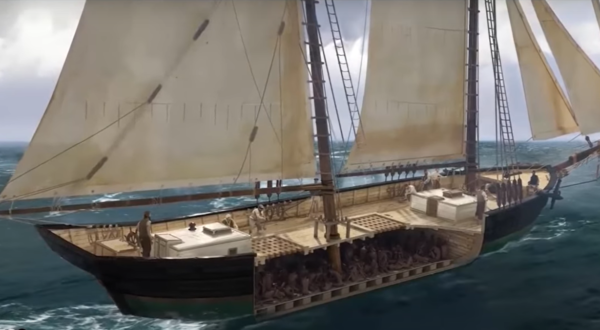Researchers Start 10-Day Evaluation of Remnants from the Last Slave Ship to Voyage to the United States
More than 160 years after it was burnt and sunk, the last known slave ship to have brought African human cargo to America has been located. Historians discovered the craft, noting it is the most complete slave ship to have ever been discovered.

Wreckage on the Alabama coast near the Mobile River, near 12 Mile Island, and just north of the Mobile Bay delta, was confirmed as that of the Clotilda in 2019 some months after it was found.
On Monday, May 2, the Alabama Historical Commission announced it is directing a collective of researchers to commence a 10-day evaluation of remnants of the wreckage.
At the time of the Clotilda’s arrival in 1860, the importation of slaves to the United States had been outlawed since Jan. 1, 1808. The ship bore approximately 110 West Africans despite this ban, and the mission had been financed by wealthy Alabama businessman Timothy Meaher.
Some of those individuals captured on the ship started a community called Africatown USA north of Mobile after the Civil War. Descendants of Meaher still live in the area.
The team hired is called the Resolve Marine, a company that specializes in salvaging and serving vessels. In December 2021, the organization announced it would start its Phase 3 exploration and site evaluation on the ship.
Over the next few months, Resolve Marine conducted a high-resolution sonar survey and marine geological study of the site where the vessel was discovered. The team will “install, operate and manage oceanography meters” at the ship and “oversee a biological assessment of the site’s benthic zone.”
To assess the condition of the Clotilda, it will review the hull and conduct and examine a limited artifact excavation, wood samples from the vessel, and more.
“We are pleased to be part of this historically important preservation project. It is a tremendous duty to ensure the Clotilda is evaluated and preserved.” Aaron Jozsef, project manager at Resolve Marine said.
“Our participation in Phase 3 of the multi-year project will add to the collective understanding of the vessel and the site’s potential to yield significant archaeological information about the ship and its final voyage.”
Clotilda was authenticated by the Commission and Southeastern Archaeological Research, Inc (SEARCH Inc.), a group of maritime archaeologists and divers who specialize in historic shipwrecks, according to the Smithsonian Mag.
In 2017, the Smithsonian National Museum of African American History and Culture’s Slave Wrecks Project (SWP) co-director Paul Gardullo started the search after speaking to residents from Africatown once they decided to contribute to the search and preservation efforts for the Clotilda.
“This was a search not only for a ship. This was a search to find our history, and this was a search for identity, and this was a search for justice,” explained Gardullo. “This is a way of restoring truth to a story that is too often papered over. Africatown is a community that is economically blighted and there are reasons for that. Justice can involve recognition. Justice can involve things like hard, truthful talk about repair and reconciliation.”
When the ship was discovered, researchers found much of the ship still intact at the bottom of the river. This includes the holding pen used to imprison Africans.
The state has donated $1 million, according to Jozsef and it will be used to “add to the collective understanding of the vessel and the site’s potential to yield significant archaeological information about the ship and its final voyage.”
Two-thirds of the ship remained protected by freshwater and mud after years of being submerged and parts that have survived are bulkheads and other modifications showing the Clotilda was once a trading schooner and later made into a slaver.
James Delgado, a maritime archaeologist who leads research on the Clotilda for SEARCH Inc., said in an interview with National Geographic, “This is the most intact slave ship known to exist in the archeological record anywhere.”
His team and history records suggest William Foster, the captain of the Clotilda, tried to destroy the evidence of his crime of transporting slaves by burning the ship.
“There’s actual direct physical evidence not just of the ship and its use, but also of the changes done by Foster and his crew to make it a slave ship,” Delgado shares. “We can say what the size is of the area where people were held, and that was a very sobering and emotionally powerful moment for the team to see.”
The team also believes they may find human DNA from traces of bodily fluids or excrement as they excavate between the ship’s planking.
Stacye Hathorn, State Archaeologist with the Alabama Historical Commission does not believe that any data will be retrieved because of how delicate the process is with these kinds of projects.
“One of the problems you have is that as you excavate something, you destroy context, and context tells the story,” Hathorn remarks. “You have to be very careful to gather all the information you can because you only have one shot at it. You don’t preserve things by destroying them.”
Between the early 16th century and the 19th century, and an estimated 35,000 voyages, more than 12.5 million Africans were forcibly taken across the Atlantic to the Americas, a horrific journey that historians call the Middle Passage or the MAAFA. Of those ships, between 500 to a thousand were wrecked. Only a handful of those wrecked ships were ever located.


